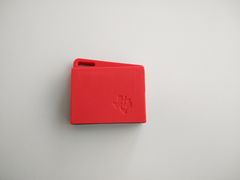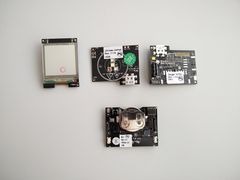Difference between revisions of "IndoorGeoloc2016"
| (17 intermediate revisions by 2 users not shown) | |||
| Line 1: | Line 1: | ||
| + | RICM4 Polytech Grenoble project in Geolocalisation Indoor using geolocating technologies which can be beacons BLE from Apple [[iBeacon]] or [[AltBeacon]]. |
||
| − | Technologies de géolocalisation indoor |
||
| − | Balises (beacon) BLE Apple [[iBeacon]] & [[AltBeacon]] |
||
| − | = Preambule = |
||
= Project presentation = |
= Project presentation = |
||
| − | * Triangularistion de signaux Bluetooth 4.0 des beacons |
||
| − | * Affichage temps réel des positions de porteurs de beacons sur une carte OpenStreetMap indoor |
||
| − | ==Matériel== |
||
| − | * Téléphones Android |
||
| ⚫ | |||
| − | * 3 iTag |
||
| − | * Texas Instrument SimpleLink Multi-Standard SensorTag development kit |
||
| + | Nowadays, geolocalisation has become a wide spread technology. It is used in order to guide a user from a first point A to another point B, naming it can allow users to have routing help during a travel, such as driving trip or even going to a coffee. In this way, geolocalisation is incredibly well spread outdoor, it's in this case that geolocalisation is the most efficient. |
||
| ⚫ | |||
| + | But, what about indoor geolocalisation ? Because of the use of satellites and GSM networks to locate an object, it is a harder to use it indoor. Buildings prevent signals to enter making impossible to locate things with those means. And this where our project takes place ! |
||
| ⚫ | |||
| + | = Material = |
||
| − | = Progress of the project = |
||
| + | * Android cellphones |
||
| − | == Week 1 (January 11th - January 17th) == |
||
| ⚫ | |||
| − | * Choice of the project |
||
| + | * 2 sensorTag 1st generation |
||
| + | * 1 sensorTag 2nd generation |
||
| + | * 2 Débug dev pack |
||
| + | * LED audio dev pack |
||
| + | * Watch dev pack |
||
| + | * 1 Genuino 101 |
||
| + | * 2 Intel Quark Microcontroller Dev Kit D2000 |
||
| + | * Emetteur/Récepteur Bluetooth(port série) |
||
| + | <gallery mode="packed-hover" height="180"> |
||
| − | == Week 2 (January 18th - January 24th) == |
||
| + | File:Stm32 bluetooth.jpg|''[[Stm32 bluetooth board]]'' |
||
| − | * Discovery of the project |
||
| + | File:TI beacon debug.jpg|''[[TI beacon board plugged with debug module]]'' |
||
| − | * Discovery of the already existing technologies |
||
| + | File:TI sensorTag protection.jpg|''[[SensorTag in its protection]]'' |
||
| − | * Test of the given instruments (iTag, STM32...) |
||
| + | File:TI sensortag.jpg|''[[TI SensorTag]]'' |
||
| − | * Writing the requirements specifications |
||
| + | File:Genuino 101.jpg|''[[Genuino 101]]'' |
||
| + | </gallery> |
||
| ⚫ | |||
| − | == Week 3 (January 25th - January 31st) == |
||
| ⚫ | |||
| − | * Writing of the UML diagrams |
||
| − | * Definition of the structure of the project |
||
| − | == Week 4 (February 1st - February 6th) == |
||
| − | * Receipt of the TI Simplelink SensorTag |
||
| − | * |
||
| ⚫ | |||
| − | == Week 5 (February 7th - February 13th) == |
||
| + | The main goal of the project is to enable people to locate things (objects or people) indoor. Thanks to better fitting technologies in this context, it is now possible to obtain a precise location of an object. |
||
| − | == Week 6 (February 14th - February 20th) == |
||
| + | Using Bluetooth Low Energy technology, objects are located indoor with micro controllers placed in different corners all over the building. Those micro controllers then transmit the data concerning the object to a server which will transform them in order to display them on an OpenStreetMap map. |
||
| − | == Week 7 (February 21st - February 27th) == |
||
| − | |||
| ⚫ | |||
=Liens= |
=Liens= |
||
| Line 47: | Line 42: | ||
** http://enzomolion.github.io/BLEfinder/ |
** http://enzomolion.github.io/BLEfinder/ |
||
** https://github.com/EnzoMolion/BLEfinder |
** https://github.com/EnzoMolion/BLEfinder |
||
| + | * IEEE Registar https://standards.ieee.org/develop/regauth/ |
||
| + | * IBeacon location research https://github.com/jpias/beacon-pfilter-simulation/wiki |
||
Latest revision as of 10:41, 27 January 2017
RICM4 Polytech Grenoble project in Geolocalisation Indoor using geolocating technologies which can be beacons BLE from Apple iBeacon or AltBeacon.
Project presentation
Nowadays, geolocalisation has become a wide spread technology. It is used in order to guide a user from a first point A to another point B, naming it can allow users to have routing help during a travel, such as driving trip or even going to a coffee. In this way, geolocalisation is incredibly well spread outdoor, it's in this case that geolocalisation is the most efficient. But, what about indoor geolocalisation ? Because of the use of satellites and GSM networks to locate an object, it is a harder to use it indoor. Buildings prevent signals to enter making impossible to locate things with those means. And this where our project takes place !
Material
- Android cellphones
- STM32 Nucleo equiped with shield BLE X-NUCLEO-IDB04A1
- 2 sensorTag 1st generation
- 1 sensorTag 2nd generation
- 2 Débug dev pack
- LED audio dev pack
- Watch dev pack
- 1 Genuino 101
- 2 Intel Quark Microcontroller Dev Kit D2000
- Emetteur/Récepteur Bluetooth(port série)
Team
This project is directed by Didier Donsez and designed by Diana Stoian, Quentin Faure, Damien Crastes de Paulet (team leader), Imad-Seddik Arrada. The four of us are currently studying in their first year of Polytech master degree. The project is part of the Software Development course.
Summary
The main goal of the project is to enable people to locate things (objects or people) indoor. Thanks to better fitting technologies in this context, it is now possible to obtain a precise location of an object. Using Bluetooth Low Energy technology, objects are located indoor with micro controllers placed in different corners all over the building. Those micro controllers then transmit the data concerning the object to a server which will transform them in order to display them on an OpenStreetMap map.
Liens
- Beacons, 22 utilisations hors magasin à connaître avant 2015
- VT2015 Geolocalisation Indoor
- Enzo Molion, Stage d'excellence, Université Joseph Fourier, 2015
- IEEE Registar https://standards.ieee.org/develop/regauth/
- IBeacon location research https://github.com/jpias/beacon-pfilter-simulation/wiki



